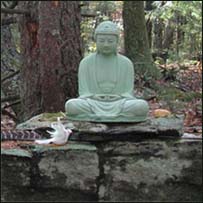|
|
 |
Please support Dharma Seed with a 2025 year-end gift.
Your donations allow us to offer these teachings online to all.

|

|

|
The greatest gift is the
gift of the teachings
|
|

|
| |
|
Dharma Talks
in English
|
2009-11-11
Emptiness & Compassion III
64:01
|
|
Donald Rothberg
|
|
|
We review the teachings on emptiness in the context of the broader teachings on the centrality of developing wisdom and compassion, expanding our examination of these teachings from last time. The last part of the session involving doing several exercises, partly explaining experience as a flowing "stream" (and seeing what obstructs the flow) and partly doing a series of four exercises with "ordinary objects" designed to take us out of our ordinary way of constructing things.
|
|
Spirit Rock Meditation Center
:
Monday and Wednesday Talks
|
|
|
2009-11-10
Meditation for Life
47:11
|
|
Martine Batchelor
|
|
|
Meditation is not an idea of getting to a mystical state but of helping us to release. It is not an exotic practice but it is more like eating, brushing our teeth - it is a way to nourish ourselves and to open and finally to let go.
It is a lifelong journey where we learn to let go and stop grasping as we become aware of our life in each moment, accept each moment as it is.
Meditation can help us to be more in the world, by being here and now we can be skillful and respond to whatever happens in the present.
We develop clarity, we see the changing nature of things. When we are engulfed by feelings we can step back and say ‘how long will this last?’ We do not have to feed the feelings, we just need to be with them and watch them as they change.
We can bring creative awareness to everything that we do and use it to be fully where we are, to be in our relationships in our life.
|
|
Insight Meditation South Bay - Silicon Valley
|
|
|
2009-11-07
Entering the Stream
59:49
|
|
Stephen Batchelor
|
|
|
A reflection on the meaning of "stream entry" (sotapatti), based upon Pali canonical sources. The "stream" refers to the eightfold path and the "stream entrant" is one who has made that path their own. The talk explores the meaning of the three fetters that are "abandoned" on entering the stream as well as how stream entry is related to the three refuges.
|
|
Spirit Rock Meditation Center
:
Meditation and Study Retreat
|
|
|
2009-11-06
The Mature Heart - the Integration of the Four Brahmaviharas
1:12:48
|
|
Donald Rothberg
|
|
|
Preceded by a short chant by Rebekkah La Dyne, our yoga teacher for the retreat, we explore two main modes of transformation - one going into suffering, one involving beautiful states. We then focus on the latter, as expressed in the practice of the Brahmaviharas, the cultivation of lovingkindness, compassion, joy, and equanimity - examining their near and far enemies, and how the four interpret each other in the mature heart.
|
|
Spirit Rock Meditation Center
:
Cultivating Clear Seeing, Opening the Heart
|
|
|
2009-11-03
The Poisoned Arrow
60:43
|
|
Stephen Batchelor
|
|
|
A reflection on the Buddha's parable of the "poisoned arrow" (Malunkyaputta Sutta M63). This key text illustrates how the Dhamma is therapeutic, pragmatic and not concerned with metaphysical questions, which the Buddha regards as irrelevant and refuses to comment upon. What he does comment upon is the Four Noble Truths. The talk concludes with a reflection on the Buddha's account of his awakening as an insight into conditioned arising.
|
|
Spirit Rock Meditation Center
:
Meditation and Study Retreat
|
|
|
2009-11-02
The City
61:18
|
|
Stephen Batchelor
|
|
|
As the first of a series of 6 talks, Stephen outlines his project to "deconstruct" Buddhism in order to uncover the foundational ideas in which it is erected. He then analyzes the Buddha's metaphor of the "ancient path that leads to an ancient city" to suggest that the core teachings of the Dhamma are to be seen as forming the template for a restored civilization...
|
|
Spirit Rock Meditation Center
:
Meditation and Study Retreat
|
|
|
2009-10-21
Behind the Mask
49:00
|
|
Tara Brach
|
|
|
The development of a mask or persona based on our activities and roles is a natural way the ego tries to protect and enhance itself. Yet unless we wake up from our identification with the mask, we are unable to discover the truth and wholeness of what we are. This talk investigates how our masks manifest and the process of wise attention that can free us from a limiting sense of separate self. Includes a guided meditation.
|
|
Insight Meditation Community of Washington DC
:
IMCW Wednesday Evening Talks
|
|
|
2009-10-16
Empty Yourself of Fear
25:03
|
|
Ayya Medhanandi
|
|
|
One night, while Malani was dying, we gathered a group of her close friends to meditate with her. Each breath was a struggle yet she stayed aware, serene, composed, and at peace. We listened in silence, breathing freely – but our minds were not free. We knew all is impermanent, that we can die at any time. Yet we carry on as if we have forever. So we try again, everyday, to practise living in awareness. One moment at a time, empty yourself of fear and let go the world. Listen to the silence and wake up – like dear Malani.
|
|
Ottawa Buddhist Society
|
|
|
|
|